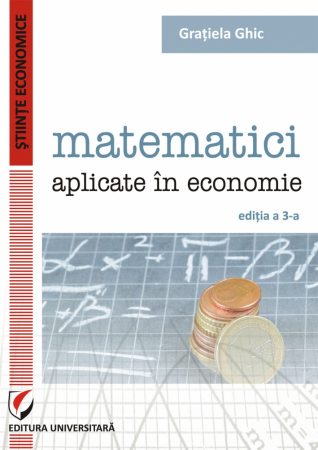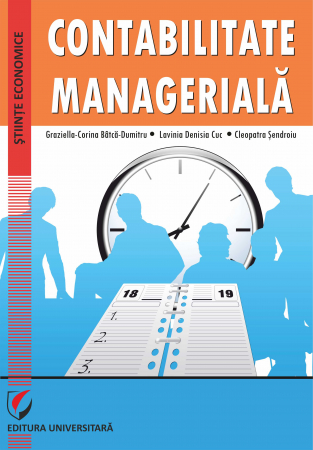Manuscript proposals: [email protected] / 0745 204 115 //// Tracking orders Individuals / Sales: 0745 200 357 / Orders Legal entities: 0721 722 783
Publisher: Editura Universitară
Author: Florina Stan Roman
ISBN: 978-606-591-969-3
DOI: 10.5682/9786065919693
Publisher year: 2014
Edition: I
Pages: 240
Product Code:
9786065919693
Do you need help?
0745 200 357
- Description
- Download (1)
- Authors
- Content
- More details
- Reviews (0)
The paper is intended to be, on the one hand, a tool in facilitating the decision-making and managerial process, because it presents the statistical terms in alphabetical order, these being easy to identify, calculate and interpret, and on the other hand, the paper is a course of statistics, a new form of presentation of the theory of statistics, coming to the aid of students, especially those studying economic disciplines, but not only, to understand, apply and retain statistical theory, forming the habit of economic reasoning based on calculations rigorous statistics. Thus, the paper is addressed especially to the students of the Academy of Economic Studies, from all the faculties that study Statistics. It is structured in chapters, in alphabetical order.
-
Statistica de la A la Z
Download
FLORINA STAN ROMAN
Chapter 1 / 23
01. Deviation / 23
02. Individual deviation / 23
03. Absolute individual deviation / 23
04. Relative individual deviation / 24
05. Interquantilic deviation / 24
06. Interquartile deviation / 25
07. Interdecylic deviation / 26
08. Maximum deviation / 26
09. Absolute positive maximum deviation / 26
10. Maximum negative absolute deviation / 27
11. Maximum positive relative deviation / 27
12. Maximum negative relative deviation / 27
13. Average deviation / 28
14. Median deviation / 30
15. The mean square deviation / 31
16. Adequacy / 34
17. Aggregation / 34
18. Aggregate / 34
19. Adjustment / 34
20. Amplitude / 35
21. Amplitude of scattering or variation / 35
22. Absolute amplitude of scattering / 35
23. Relative amplitude of scattering / 36
24. ANOVA / 37
25. Flattening / 46
26. AR / 48
27. ARMA / 50
28. Asymmetry / 51
29. Absolute asymmetry / 55
30. Asynchronous / 55
31. Statistical association / 55
32. Autocorrelation / 56
Chapter 2 / 58
33. Bias / 58
34. Boltire / 58
Chapter 3 / 59
35. Statistical characteristic (see statistical variable) / 59
36. Turnover / 59
37. Internal circulation / 64
38. Global circulation / 65
39. Coefficient of association proposed by Yulle / 65
40. Yule's association coefficient / 65
41. Asymmetry coefficient / 67
42. Vaulting coefficient / 67
43. The correlation coefficient of the ranks / 67
44. Spearman's rank correlation coefficient / 67
45. Kendall's rank correlation coefficient / 68
46. Coefficient of variation / 70
47. Interquartile coefficient of variation / 72
48. Quality control / 72
49. Quantitative control / 73
50. Statistical correlation / 73
51. Corelogram / 73
52. Market share / 74
53. Covariant / 75
54. Schedule / 76
55. Quantities / 76
56. Cuartila / 77
57. Concentration curve / 78
58. Cumulative frequency curve / 80
Chapter 4 / 82
59. Structure diagram / 82
60. Diagram by strips / 83
61. Column diagram / 83
62. Polar (radial) diagram / 83
63. Decila / 83
64. Dispersion / 85
Chapter 5 / 90
65. First error / 90
66. Second error / 90
67. Statistical error / 90
68. Gross operating surplus / 92
69. Net operating surplus / 93
70. Extrapolation / 94
Chapter 6 / 97
71. Mass phenomena / 97
72. Stochastic phenomena / 97
73. Deterministic phenomena / 97
74. Frequency / 98
75. Cumulative absolute frequency ascending / 98
76. Cumulative decreasing absolute frequency / 98
77. Absolute frequency of the group / 99
78. Relative frequency of a group / 100
Chapter 7 / 101
79. Graph by columns or strips / 101
Chapter 8 / 103
80. Histogram / 103
Chapter 9 / 104
81. Statistical indicator / 104
82. Derivative indicators / 104
83. Physical indicators / 104
84. Frequency indicators / 104
85. Absolute frequency indicators / 105
86. Relative frequency indicators / 105
87. Level indicators / 106
88. Average position indicators / 106
89. Primary indicators / 106
90. Relative indicators / 106
91. Simple indicators of scattering or variation / 107
92. Absolute synthetic indicators / 108
93. Derived synthetic indicators / 108
94. Synthetic indicators of scattering or variation / 108
95. Statistical indicators / 108
96. Central trend indicators / 108
97. Index / 109
98. Edgeworth Index / 110
99. Elementary indices / 110
100. Fisher / 111 Index
101. Gini Index / 112
102. Laspeyres Index / 114
103. Average index / 114
104. Paasche Index / 115
105. Synthetic indices / 115
106. Aggregate synthetic index / 115
107. Synthetic indices calculated as average of Individual indices / 117
108. Synthetic indices calculated as a ratio of two averages / 119
109. Continuous interval / 119
110. Discontinuous or discrete interval / 119
111. Grouping interval / 120
112. Statistical hypothesis / 120
113. Null hypothesis / 120
114. Alternative hypothesis / 120
Chapter 10 / 122
115. Asynchronous connections / 122
116. Functional connections / 122
117. Links / 123
118. Synchronous connections / 123
119. Stochastic or statistical links / 123
120. Simple connections / 124
121. Law of large numbers / 124
Chapter 11 / 125
122. Commercial margin / 125
123. Absolute size / 125
124. Medium size / 122
125. Relative size / 126
126. Relative coordination sizes / 126
127. Relative dynamics quantities / 127
128. Relative intensity quantities / 127
129. Relative sizes of the plan (provisions) / 128
130. Relative structure sizes / 130
131. Media / 131
132. Median / 132
133. Arithmetic mean / 134
134. Media harmonica / 146
135. The average of the alternative characteristic / 148
136. Chronological media / 149
137. Weighted chronological average / 149
138. Simple chronological average / 150
139. Geometric average / 151
140. Media patratica / 153
141. Method of dispersive analysis. Determination Report / 153
142. The correlation coefficient method / 156
143. Rank correlation method / 160
144. Covariant method / 160
145. Indices method / 160
146. Nonparametric methods / 162
147. Parametric methods / 16
148. Correlation ratio method / 162
149. Regression method / 166
150. The method of the association table and of the Association coefficient / 171
151. Econometric model / 173
152. Absolute change / 175
153. Average absolute change / 176
154. Module / 177
155. Moment of order k / 179
Chapter 12 / 182
156. Level of significance / 182
Chapter 13 / 183
157. Galton's Ogive / 183
Chapter 14 / 184
158. Purchasing power parity / 184
159. Polygon of frequencies / 185
160. Statistical population / 186
161. Industrial production / 187
162. Gross Domestic Product / 188
163. Exercise production or global (gross) production / 191
164. Production of fixed assets / 192
165. Production of manufactured goods / 194
166. Production of goods sold and collected / 196
167. Net Domestic Product / 196
168. Gross National Product / 197
169. Produs National Net / 199
170. Net profit related to production activity / 200
Chapter 15 / 201
171. Rate of return / 201
172. Critical region / 201
173. Sturges's relation / 202
174. Risk of the first kind / 202
175. Rhythm / 202
176. Average Rhythm / 202
177. Inventory rotation / 202
Chapter 16 / 204
178. Interval scale (cardinal) / 204
179. Nominal scale / 204
180. Ordinal scale (categorical) / 205
181. Report scale / 205
182. Cointegrated series / 206
183. Chronological series / 206
184. Chronological series of intervals / 207
185. Chronological series of moments / 207
186. Two-dimensional frequency distribution series / 208
187. One-dimensional frequency distribution series / 210
188. Heterograde one-dimensional frequency distribution series (by a numerical variable) / 210
189. Frequency distribution series on variation intervals 211 190.Frequency distribution series on variants (discrete) / 211
191. Homograde one-dimensional frequency distribution series (by a non-numerical variable) / 212
192. Integrated series / 212
193. Statistical series / 213
194. Stationary series / 213
195. Non-stationary series / 213
196. Simple random survey / 214
197. Statistics / 216
198. Descriptive statistics / 216
199. Inferential Statistics / 217
Chapter 17 / 218
200. Bartlett test / 218
201. Dickey-Fuller test / 218
202. Durbin-Watson test / 220
203. Test F (Snedecor) / 220
204. Nonparametric tests / 221
205. Park Test / 221
206. Parametric tests / 221
207. Statistical test / 222
208. Student test (t test) / 222
209. Test U / 224
210. Test Z (Fisher) / 226
Chapter 18 / 227
211. Statistical unit / 227
212. Natural-conventional units of measurement / 227
213. Natural (physical) units of measurement / 228
Chapter 19 / 229
214. Absolute value of a change percentage / 229
215. Added value / 229
216. Gross value added / 230
217. Net value added / 231
218. Alternative variable / 231
219. Qualitative variable / 231
220. Quantitative variable / 231
221. Statistical variable (see statistical characteristic) / 231
222. Continuous variable / 232
223. Discontinuous variable / 232
224. National Income (VN) (see National Net Product) / 232
225. Nominal income / 232
226. Venit Personal / 233
227. Disposable Personal Income of Households / 233
228. Speed of movement of goods / 234
Chapter 20 / 229
229. Yule U. G./229
Bibliography / 237
01. Deviation / 23
02. Individual deviation / 23
03. Absolute individual deviation / 23
04. Relative individual deviation / 24
05. Interquantilic deviation / 24
06. Interquartile deviation / 25
07. Interdecylic deviation / 26
08. Maximum deviation / 26
09. Absolute positive maximum deviation / 26
10. Maximum negative absolute deviation / 27
11. Maximum positive relative deviation / 27
12. Maximum negative relative deviation / 27
13. Average deviation / 28
14. Median deviation / 30
15. The mean square deviation / 31
16. Adequacy / 34
17. Aggregation / 34
18. Aggregate / 34
19. Adjustment / 34
20. Amplitude / 35
21. Amplitude of scattering or variation / 35
22. Absolute amplitude of scattering / 35
23. Relative amplitude of scattering / 36
24. ANOVA / 37
25. Flattening / 46
26. AR / 48
27. ARMA / 50
28. Asymmetry / 51
29. Absolute asymmetry / 55
30. Asynchronous / 55
31. Statistical association / 55
32. Autocorrelation / 56
Chapter 2 / 58
33. Bias / 58
34. Boltire / 58
Chapter 3 / 59
35. Statistical characteristic (see statistical variable) / 59
36. Turnover / 59
37. Internal circulation / 64
38. Global circulation / 65
39. Coefficient of association proposed by Yulle / 65
40. Yule's association coefficient / 65
41. Asymmetry coefficient / 67
42. Vaulting coefficient / 67
43. The correlation coefficient of the ranks / 67
44. Spearman's rank correlation coefficient / 67
45. Kendall's rank correlation coefficient / 68
46. Coefficient of variation / 70
47. Interquartile coefficient of variation / 72
48. Quality control / 72
49. Quantitative control / 73
50. Statistical correlation / 73
51. Corelogram / 73
52. Market share / 74
53. Covariant / 75
54. Schedule / 76
55. Quantities / 76
56. Cuartila / 77
57. Concentration curve / 78
58. Cumulative frequency curve / 80
Chapter 4 / 82
59. Structure diagram / 82
60. Diagram by strips / 83
61. Column diagram / 83
62. Polar (radial) diagram / 83
63. Decila / 83
64. Dispersion / 85
Chapter 5 / 90
65. First error / 90
66. Second error / 90
67. Statistical error / 90
68. Gross operating surplus / 92
69. Net operating surplus / 93
70. Extrapolation / 94
Chapter 6 / 97
71. Mass phenomena / 97
72. Stochastic phenomena / 97
73. Deterministic phenomena / 97
74. Frequency / 98
75. Cumulative absolute frequency ascending / 98
76. Cumulative decreasing absolute frequency / 98
77. Absolute frequency of the group / 99
78. Relative frequency of a group / 100
Chapter 7 / 101
79. Graph by columns or strips / 101
Chapter 8 / 103
80. Histogram / 103
Chapter 9 / 104
81. Statistical indicator / 104
82. Derivative indicators / 104
83. Physical indicators / 104
84. Frequency indicators / 104
85. Absolute frequency indicators / 105
86. Relative frequency indicators / 105
87. Level indicators / 106
88. Average position indicators / 106
89. Primary indicators / 106
90. Relative indicators / 106
91. Simple indicators of scattering or variation / 107
92. Absolute synthetic indicators / 108
93. Derived synthetic indicators / 108
94. Synthetic indicators of scattering or variation / 108
95. Statistical indicators / 108
96. Central trend indicators / 108
97. Index / 109
98. Edgeworth Index / 110
99. Elementary indices / 110
100. Fisher / 111 Index
101. Gini Index / 112
102. Laspeyres Index / 114
103. Average index / 114
104. Paasche Index / 115
105. Synthetic indices / 115
106. Aggregate synthetic index / 115
107. Synthetic indices calculated as average of Individual indices / 117
108. Synthetic indices calculated as a ratio of two averages / 119
109. Continuous interval / 119
110. Discontinuous or discrete interval / 119
111. Grouping interval / 120
112. Statistical hypothesis / 120
113. Null hypothesis / 120
114. Alternative hypothesis / 120
Chapter 10 / 122
115. Asynchronous connections / 122
116. Functional connections / 122
117. Links / 123
118. Synchronous connections / 123
119. Stochastic or statistical links / 123
120. Simple connections / 124
121. Law of large numbers / 124
Chapter 11 / 125
122. Commercial margin / 125
123. Absolute size / 125
124. Medium size / 122
125. Relative size / 126
126. Relative coordination sizes / 126
127. Relative dynamics quantities / 127
128. Relative intensity quantities / 127
129. Relative sizes of the plan (provisions) / 128
130. Relative structure sizes / 130
131. Media / 131
132. Median / 132
133. Arithmetic mean / 134
134. Media harmonica / 146
135. The average of the alternative characteristic / 148
136. Chronological media / 149
137. Weighted chronological average / 149
138. Simple chronological average / 150
139. Geometric average / 151
140. Media patratica / 153
141. Method of dispersive analysis. Determination Report / 153
142. The correlation coefficient method / 156
143. Rank correlation method / 160
144. Covariant method / 160
145. Indices method / 160
146. Nonparametric methods / 162
147. Parametric methods / 16
148. Correlation ratio method / 162
149. Regression method / 166
150. The method of the association table and of the Association coefficient / 171
151. Econometric model / 173
152. Absolute change / 175
153. Average absolute change / 176
154. Module / 177
155. Moment of order k / 179
Chapter 12 / 182
156. Level of significance / 182
Chapter 13 / 183
157. Galton's Ogive / 183
Chapter 14 / 184
158. Purchasing power parity / 184
159. Polygon of frequencies / 185
160. Statistical population / 186
161. Industrial production / 187
162. Gross Domestic Product / 188
163. Exercise production or global (gross) production / 191
164. Production of fixed assets / 192
165. Production of manufactured goods / 194
166. Production of goods sold and collected / 196
167. Net Domestic Product / 196
168. Gross National Product / 197
169. Produs National Net / 199
170. Net profit related to production activity / 200
Chapter 15 / 201
171. Rate of return / 201
172. Critical region / 201
173. Sturges's relation / 202
174. Risk of the first kind / 202
175. Rhythm / 202
176. Average Rhythm / 202
177. Inventory rotation / 202
Chapter 16 / 204
178. Interval scale (cardinal) / 204
179. Nominal scale / 204
180. Ordinal scale (categorical) / 205
181. Report scale / 205
182. Cointegrated series / 206
183. Chronological series / 206
184. Chronological series of intervals / 207
185. Chronological series of moments / 207
186. Two-dimensional frequency distribution series / 208
187. One-dimensional frequency distribution series / 210
188. Heterograde one-dimensional frequency distribution series (by a numerical variable) / 210
189. Frequency distribution series on variation intervals 211 190.Frequency distribution series on variants (discrete) / 211
191. Homograde one-dimensional frequency distribution series (by a non-numerical variable) / 212
192. Integrated series / 212
193. Statistical series / 213
194. Stationary series / 213
195. Non-stationary series / 213
196. Simple random survey / 214
197. Statistics / 216
198. Descriptive statistics / 216
199. Inferential Statistics / 217
Chapter 17 / 218
200. Bartlett test / 218
201. Dickey-Fuller test / 218
202. Durbin-Watson test / 220
203. Test F (Snedecor) / 220
204. Nonparametric tests / 221
205. Park Test / 221
206. Parametric tests / 221
207. Statistical test / 222
208. Student test (t test) / 222
209. Test U / 224
210. Test Z (Fisher) / 226
Chapter 18 / 227
211. Statistical unit / 227
212. Natural-conventional units of measurement / 227
213. Natural (physical) units of measurement / 228
Chapter 19 / 229
214. Absolute value of a change percentage / 229
215. Added value / 229
216. Gross value added / 230
217. Net value added / 231
218. Alternative variable / 231
219. Qualitative variable / 231
220. Quantitative variable / 231
221. Statistical variable (see statistical characteristic) / 231
222. Continuous variable / 232
223. Discontinuous variable / 232
224. National Income (VN) (see National Net Product) / 232
225. Nominal income / 232
226. Venit Personal / 233
227. Disposable Personal Income of Households / 233
228. Speed of movement of goods / 234
Chapter 20 / 229
229. Yule U. G./229
Bibliography / 237
By approaching and treating the problems of statistical theory in the form of a dictionary, this paper aims to present in a logical, accessible and unitary way the rich content of statistics, without claiming its complete presentation, but helping to contribute to know and analyze socio-economic phenomena.
The paper is intended to be, on the one hand, a tool in facilitating the decision-making and managerial process, because it presents the statistical terms in alphabetical order, these being easy to identify, calculate and interpret, and on the other hand, the paper is a course of statistics, a new form of presentation of the theory of statistics, coming to the aid of students, especially those studying economic disciplines, but not only, to understand, apply and retain statistical theory, forming the habit of economic reasoning based on calculations rigorous statistics. Thus, the paper is addressed especially to the students of the Academy of Economic Studies, from all the faculties that study Statistics. It is structured in chapters, in alphabetical order.
Deep gratitude to those who helped me in this work.
The author
The paper is intended to be, on the one hand, a tool in facilitating the decision-making and managerial process, because it presents the statistical terms in alphabetical order, these being easy to identify, calculate and interpret, and on the other hand, the paper is a course of statistics, a new form of presentation of the theory of statistics, coming to the aid of students, especially those studying economic disciplines, but not only, to understand, apply and retain statistical theory, forming the habit of economic reasoning based on calculations rigorous statistics. Thus, the paper is addressed especially to the students of the Academy of Economic Studies, from all the faculties that study Statistics. It is structured in chapters, in alphabetical order.
Deep gratitude to those who helped me in this work.
The author
If you want to express your opinion about this product you can add a review.
write a review

6359.png)
![Statistics from A to Z [1] Statistics from A to Z [1]](https://gomagcdn.ro/domains/editurauniversitara.ro/files/product/large/statistica-de-la-a-la-z-1017-675655.jpg)














